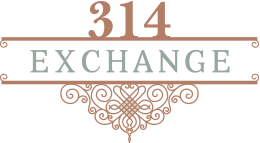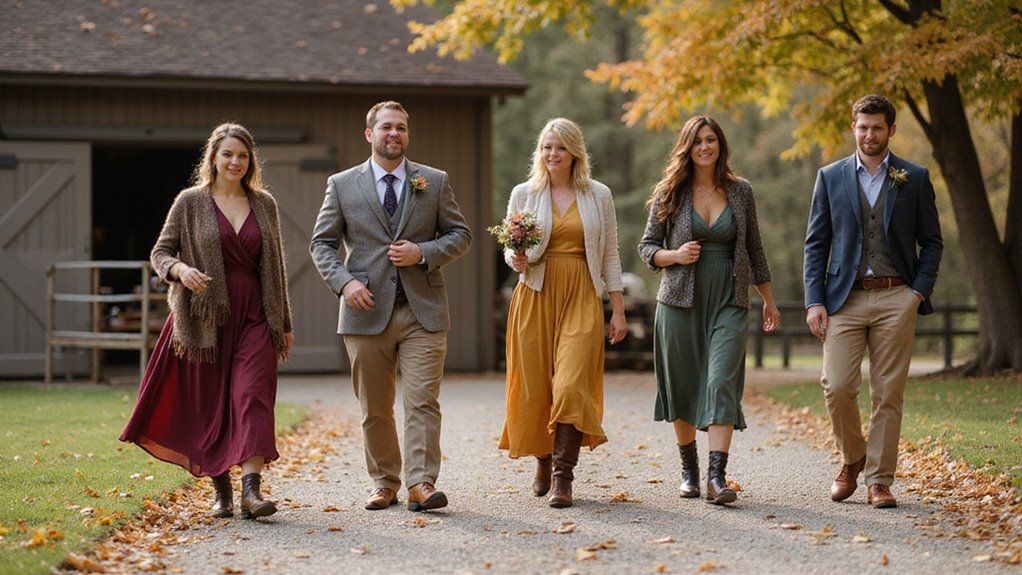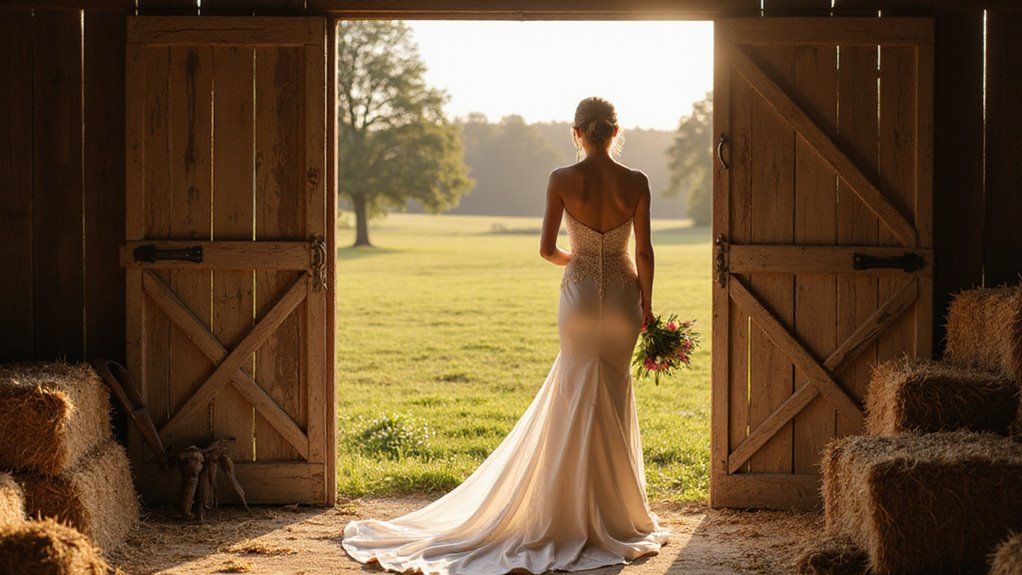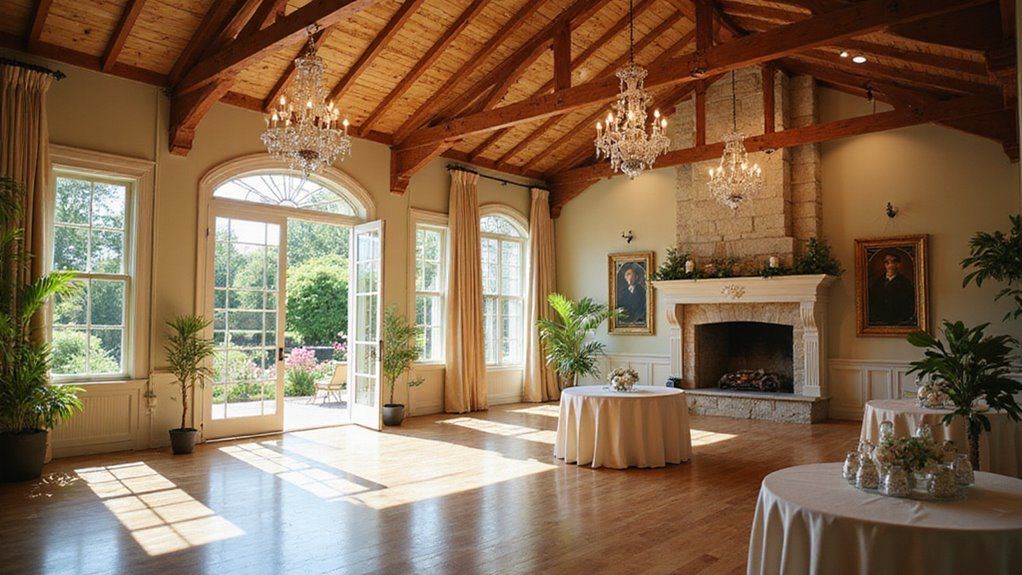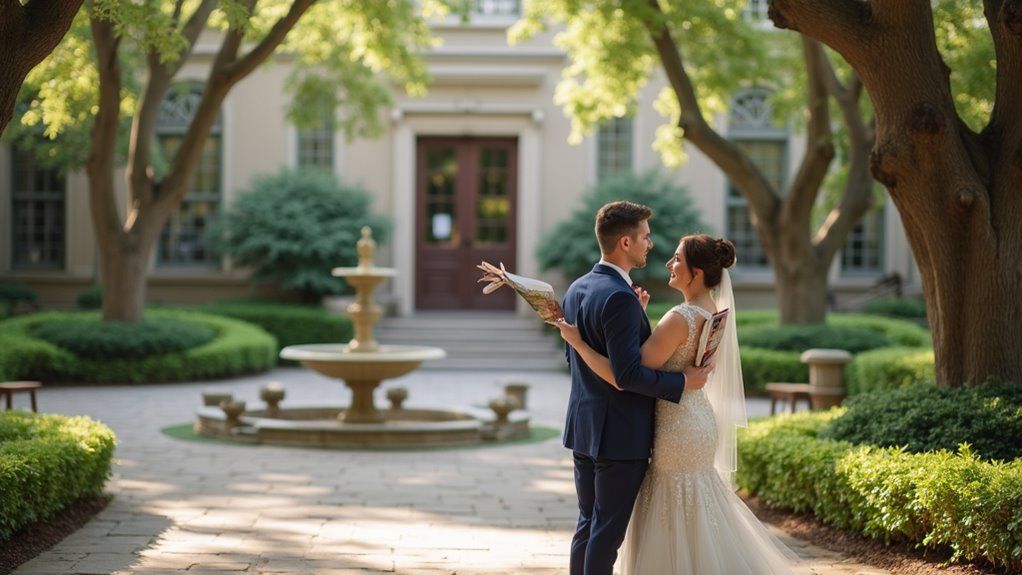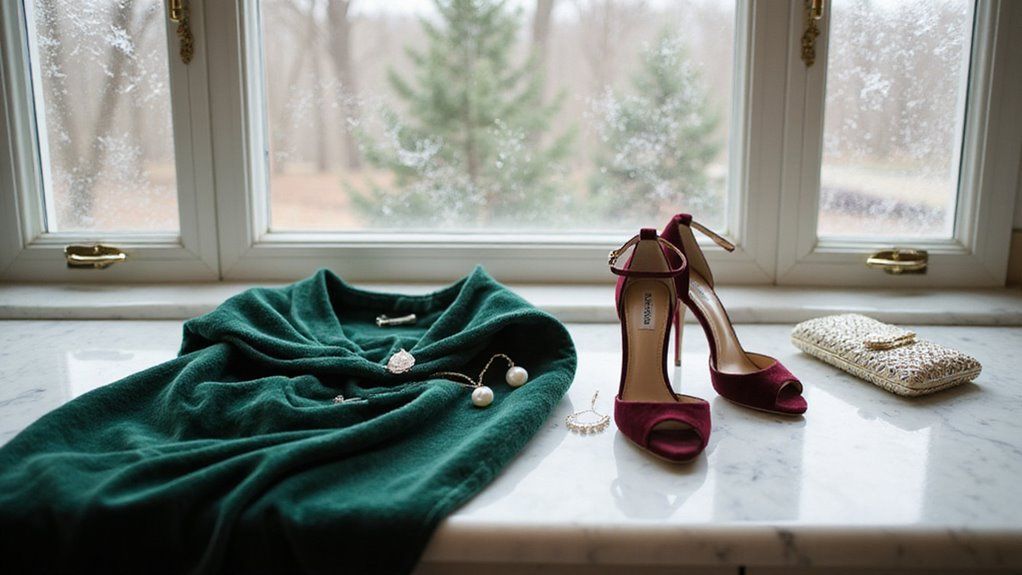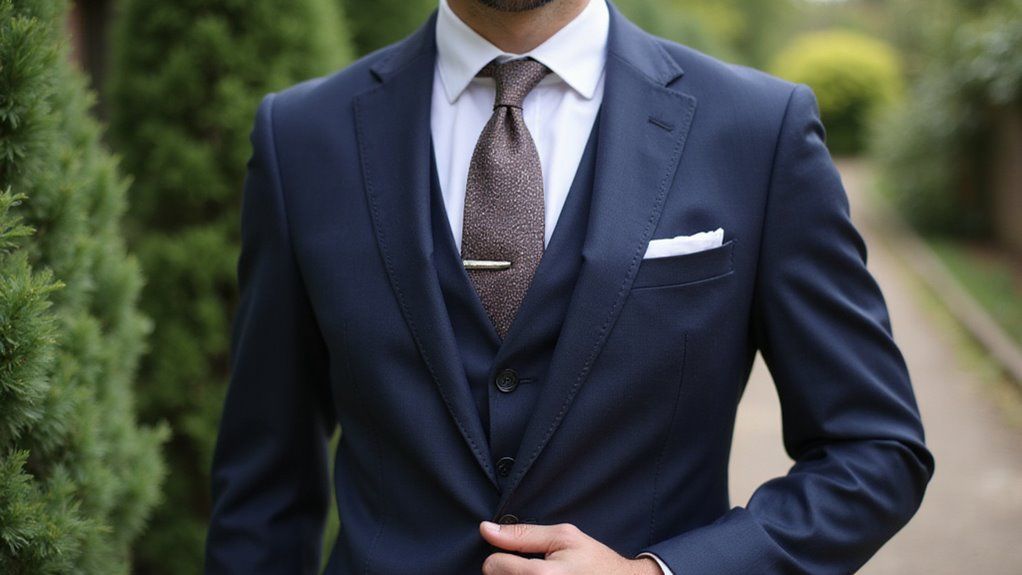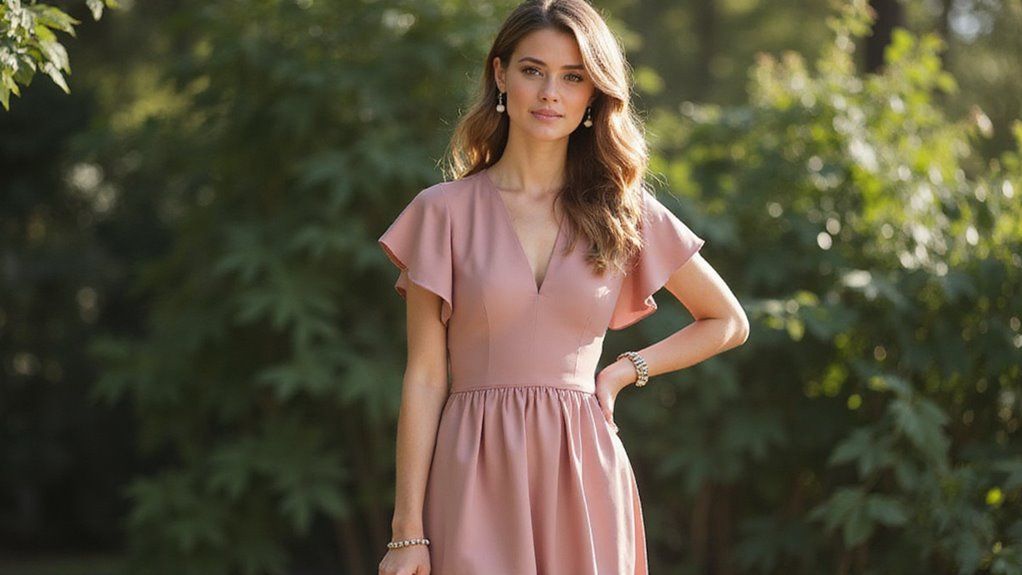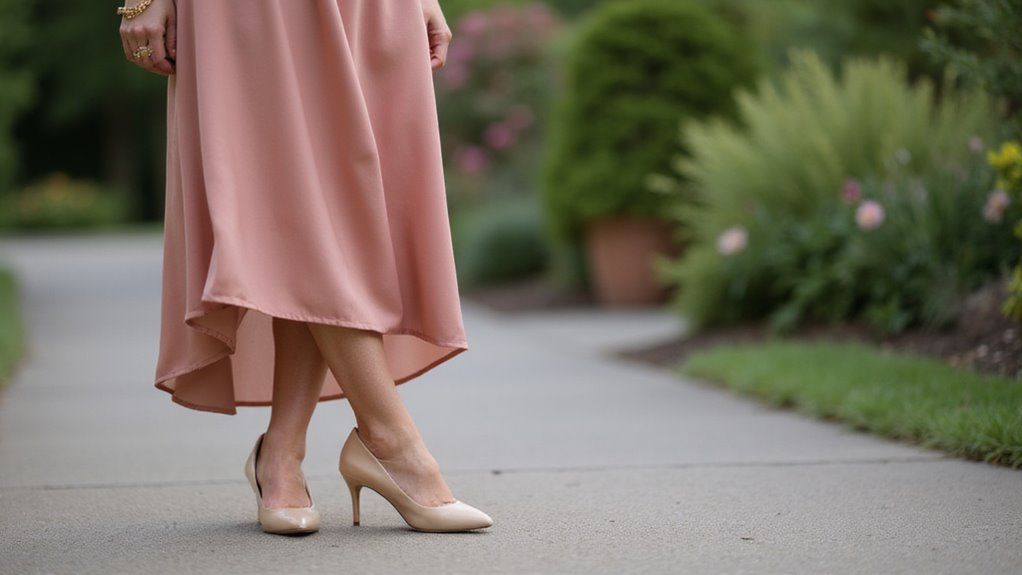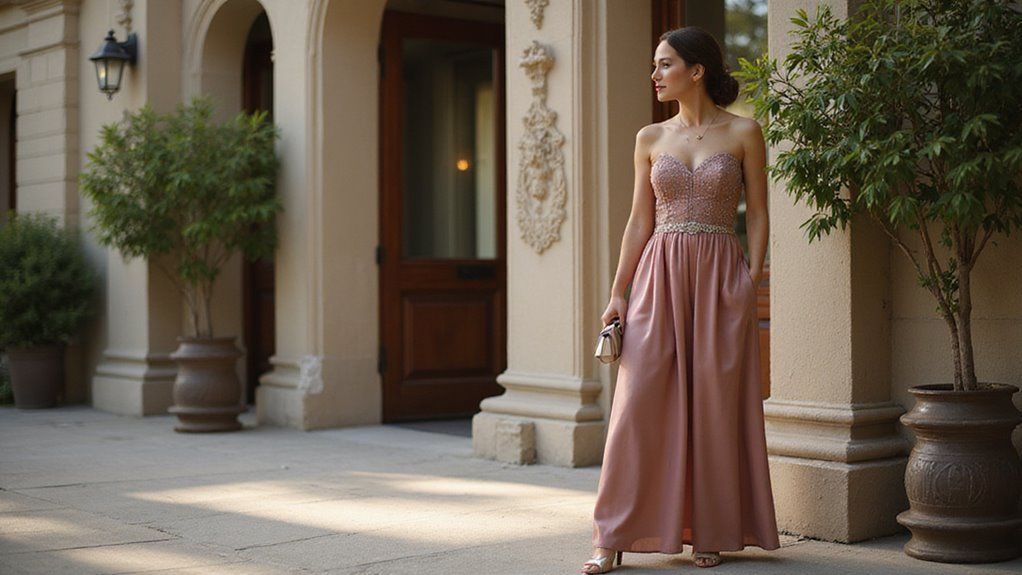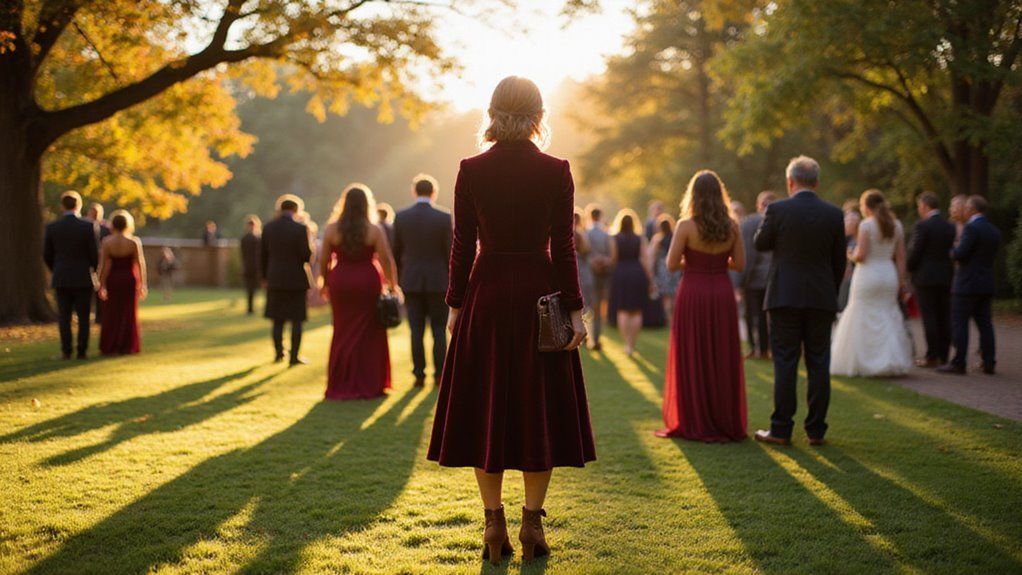What Colors Not to Wear to a Wedding
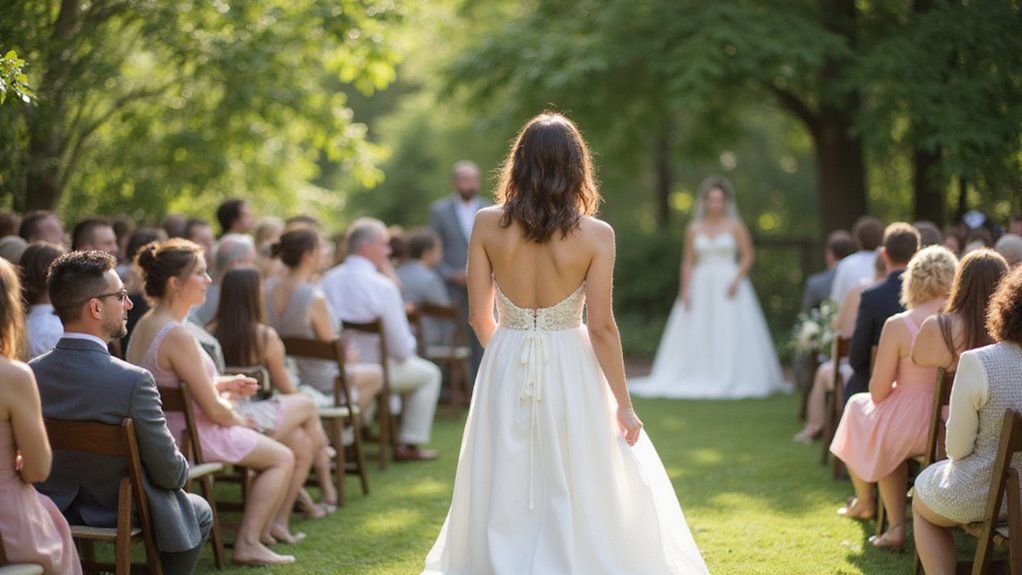
Stepping into a wedding wearing the wrong color can turn a joyous celebration into an awkward nightmare. From upstaging the bride to disrespecting cultural traditions, choosing inappropriate attire creates unnecessary tension at special ceremonies. Fortunately, navigating wedding fashion etiquette becomes simple with proper color guidance.
Never wear white, ivory, cream, or champagne shades, as these colors belong solely to the bride. Avoid black unless specified for formal evening events, and skip red at Chinese weddings. Stay away from matching the wedding party’s colors or choosing distracting neon shades.
This guide explores every aspect of selecting appropriate colors for wedding guest attire.
Key Takeaways
- Avoid white, ivory, cream, and champagne colors as these shades are traditionally reserved exclusively for the bride.
- Black may appear too somber for daytime weddings unless styled thoughtfully with colorful accessories or metallics.
- Red can be problematic in Chinese and Korean traditions, and may draw excessive attention away from the couple.
- Don’t match the wedding party’s colors exactly, as this can cause confusion in photos and ceremonies.
- Skip bright neon shades and overly flashy patterns that could distract from the event or disrupt the ambiance.
Why Are Some Colors Inappropriate for Weddings?
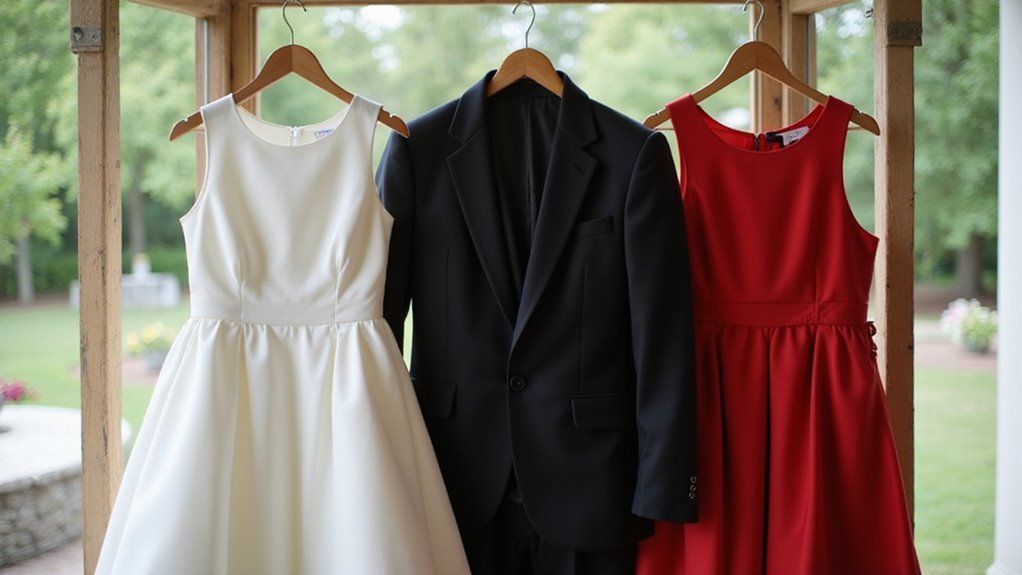
You’ll encounter color expectations at weddings that stem from traditional taboos, such as avoiding white to prevent upstaging the bride or wearing black to sidestep associations with mourning.
Cultural backgrounds also shape what’s considered respectful—red may be celebratory in some traditions but problematic in others. Modern etiquette has relaxed some rules, yet you’re still expected to consider the couple’s preferences, venue formality, and whether your outfit competes with the bridal party’s designated colors.
Traditional Color Taboos
The most common forbidden colors at weddings vary by culture and tradition. White and similar shades like ivory or cream must never be worn by wedding guests. This color belongs solely to the bride in Western traditions. Black clothing traditionally signals mourning but works well for formal evening ceremonies.
In many Asian cultures, red carries special meanings. Red dresses may offend Chinese families, where brides traditionally wear this lucky color. Similarly, gold or metallic outfits should be avoided to prevent overshadowing the wedding party.
To stay appropriate, check the couple’s cultural background before choosing your attire.
Cultural Considerations
Different cultures have specific rules and meanings for wedding colors. Chinese traditions consider white a mourning color, while red represents the bride’s good fortune and happiness. Indian weddings reserve red and gold for brides, making these shades off-limits for guests. Korean wedding etiquette discourages guests from wearing white, black, or red.
Moreover, these cultural expectations greatly influence wedding attire choices. Each tradition values certain colors differently. Contact the wedding couple or research their cultural background before choosing your outfit.
Modern Wedding Color Etiquette
Guests must avoid wearing white, ivory, cream, or champagne colors to respect the bride. These shades belong exclusively to the bride on her special day.
Colors that match the wedding party’s attire can create confusion in photos and ceremonies. Smart guests check wedding websites or invitations for the chosen color palette beforehand.
Black formal wear needs special consideration at weddings. Full black outfits may appear too somber unless specifically requested in the dress code.
In most cases, earth tones, jewel tones, and pastels work well for wedding guests. The invitation often provides clear guidance about appropriate attire colors.
What Colors Should Guests Avoid Wearing?
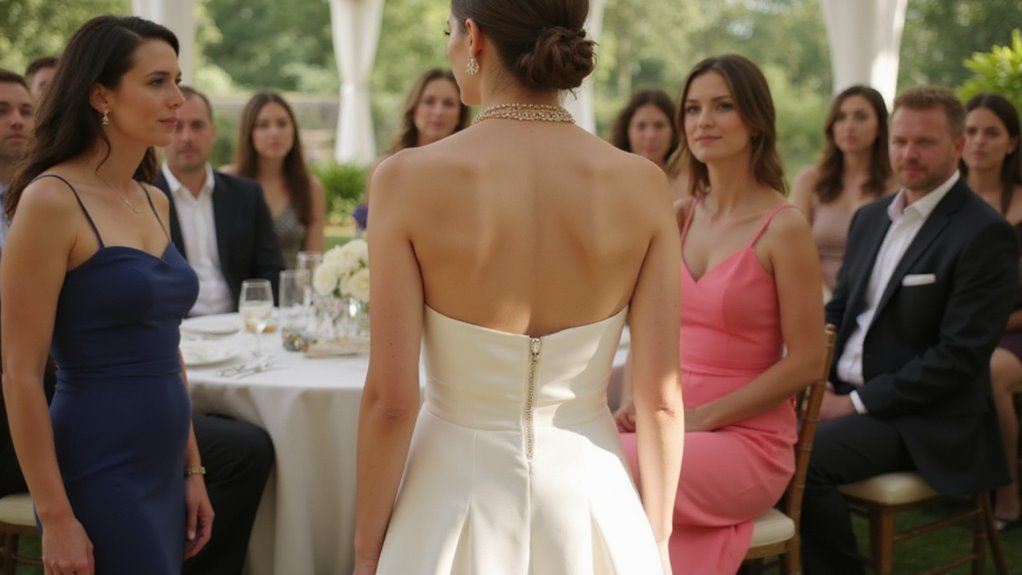
You’ll want to steer clear of white, ivory, and cream tones that traditionally belong to the bride. Avoid matching the wedding party’s designated colors unless the couple specifically requests coordinated attire.
Overly bright neon shades, head-to-toe black outfits, and attention-grabbing red can also pose etiquette concerns depending on the wedding’s formality and cultural context.
White and Ivory Tones
White and ivory outfits are not appropriate choices for wedding guests. The bride deserves to stand out in her traditional white or ivory gown on her special day.
Guests must avoid wearing solid white dresses, suits, or jumpsuits to weddings. Light neutral shades like cream, champagne, and beige should also be avoided. Multi-colored outfits with white patterns are acceptable if white isn’t the main color.
For complete clarity, guests can check the couple’s wedding website or ask the wedding party about dress code expectations.
Matching the Wedding Party Colors
Avoid matching colors with the wedding party to prevent confusion and respect the couple’s chosen aesthetic.
Wedding guests must check bridesmaids’ dress colors and groomsmen’s suit colors before selecting their outfits. The invitation or wedding website often lists these important details. A quick message to the couple or family member can clarify any uncertainty about color choices.
Moreover, this thoughtful consideration helps maintain the couple’s planned visual theme. Your unique outfit choice allows professional photos to clearly highlight the official wedding party members.
Overly Flashy or Neon Colors
Neon and flashy colors will disrupt your wedding photos and ambiance. Professional photographers struggle to capture accurate images when bright neon colors reflect harsh glares. These bold shades create unwanted distractions during key moments like vows and first dances.
Most wedding themes work best with subtle, coordinated color palettes. Traditional wedding colors include soft pastels, earth tones, and classic neutrals. Natural color schemes complement venue lighting and seasonal décor. These gentle hues allow meaningful moments to shine without visual competition. For best results, select colors that blend harmoniously with your venue and season.
All-Black Ensembles
Black clothing can work for weddings when styled thoughtfully. Mix black pieces with vibrant accessories, metallic elements, or eye-catching patterns. A colorful scarf, statement necklace, or printed shoes help lighten an all-black outfit.
Wedding dress codes traditionally discourage head-to-toe black due to funeral associations. Evening events generally accept darker attire more readily than daytime celebrations. The invitation often specifies dress code requirements.
A balanced black ensemble shows respect while maintaining celebration-appropriate style. Your outfit choices matter in honoring the couple’s special day.
Red and Its Implications
Red has deep cultural implications in various settings across societies and traditions. Red carries heavy symbolic meaning at formal events like weddings. In Chinese culture, red represents good fortune and joy during wedding celebrations. Western cultures often view bright red as too attention-grabbing for formal ceremonies.
Moreover, the context determines red’s appropriateness. Dark red shades work better for evening events, while bright reds suit casual daytime gatherings. Social etiquette experts recommend checking dress codes or asking hosts directly about color preferences.
How Do Wedding Themes Affect Color Choices?
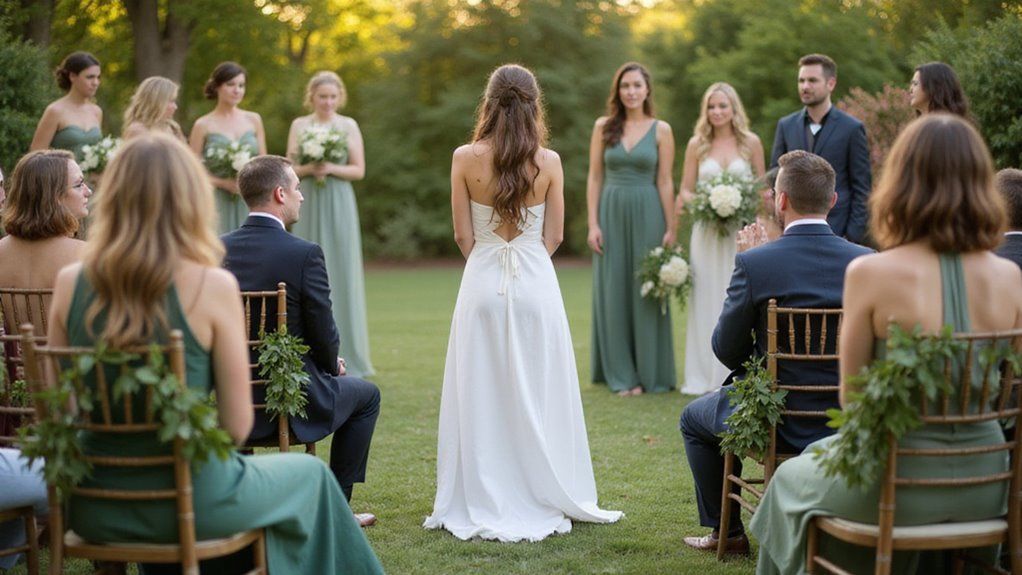
The formality and setting of a wedding directly influence which colors work for your outfit and which don’t. A black-tie ballroom event requires different color choices than a beach ceremony at sunset, and seasonal themes often come with specific palettes you’ll want to enhance rather than clash with.
You should always check the invitation or wedding website for dress code guidance, as destination weddings and themed celebrations may include explicit color requests or restrictions.
Formal Black-Tie Events
Black-tie events require elegant, sophisticated colors that match formal attire standards. Dark jewel tones like emerald, sapphire, and ruby work perfectly for these occasions. Black remains the most traditional and safest choice for formal evening events.
As a general rule, metallics such as gold, silver, and champagne complement the refined atmosphere. However, casual colors can diminish the event’s formality. Bright neons, busy patterns, and light pastels should be avoided at black-tie celebrations.
To maintain respect for the occasion, select colors that reflect the event’s upscale nature. The right color choice enhances the formal atmosphere while honoring the hosts’ vision.
Casual Outdoor Ceremonies
Casual outdoor ceremonies allow relaxed dress code choices with natural colors and comfortable styles. Soft pastels, floral prints, and light fabrics work best for garden or beach venues. The outdoor environment welcomes simple, breezy outfits that match the natural setting.
Additionally, popular color choices include coral, mint, lavender, and sky blue for daytime events. Always review the couple’s wedding website for specific dress code guidance. Most importantly, avoid flashy patterns or season-inappropriate colors that might clash with the environment.
Seasonal Wedding Color Considerations
Rich earth tones and warm colors complement autumn wedding celebrations perfectly. Deep burgundy, forest green, burnt orange, and golden yellow create an ideal fall palette. Natural elements like branches and dried flowers enhance these color choices.
The venue’s existing decorations may influence your color selection. Each culture brings unique color traditions to wedding celebrations. Many couples specify preferred colors through their invitations or wedding websites.
Furthermore, proper coordination prevents matching the wedding party’s attire too closely. Select complementary shades that work with seasonal elements while honoring any specific dress codes.
Destination Wedding Attire
Pick wedding attire that matches the location and weather conditions. Beach weddings need light fabrics like linen or chiffon in blues, corals, or soft greens. Desert venues require breathable materials in earth tones such as beige or terracotta.
Natural lighting affects how colors appear in photos. Some cultures consider certain colors inappropriate for weddings. Bright metallic fabrics can create unwanted glare in outdoor photos.
Moreover, check the venue’s dress code requirements before shopping. A backup outfit helps prepare for unexpected weather changes. Simple accessories work best for destination events.
Are There Exceptions to Wedding Color Rules?
Yes, wedding color rules have clear exceptions based on specific circumstances. Traditional wedding color guidelines allow flexibility when couples make direct color requests for their celebration. Cultural ceremonies often embrace unique color traditions that differ from Western practices. Some Asian weddings encourage vibrant reds and golds.
Furthermore, dress codes stated on invitations take precedence over standard etiquette rules. Formal instructions like “wear pastels” or “black-tie attire” override typical color restrictions. The couple’s wishes always determine appropriate guest attire.
The bottom line remains simple: respect the couple’s preferences and follow any written dress guidelines they provide.
What Colors Work Best for Different Wedding Roles?
Your role at the wedding determines your color flexibility and expectations. Family members typically coordinate with the wedding party palette but enjoy more freedom than bridesmaids or groomsmen, while close friends should align with the couple’s vision without matching the bridal party exactly.
Plus-ones and casual acquaintances have the most flexibility—simply avoid white, cream, and overly attention-grabbing colors while selecting guest-appropriate formal wear.
Family Members
Family members should follow specific dress guidelines at weddings to show respect and support for the couple.
Parents, siblings, and close relatives must avoid wearing white, ivory, or champagne colors reserved for the bride. Proper attire maintains focus on the wedding couple during their special day. Black formal wear should be minimized unless specifically requested.
Family members can coordinate their outfits beforehand to create a cohesive look. Moreover, modest and elegant choices in jewel tones or pastels work well for most ceremonies. The dress code should align with the wedding’s formality level, time of day, and season.
Close Friends
Your close friends should avoid wearing bridal colors like white, cream, or ivory to your wedding. Navy, gray, and taupe offer safe and stylish options that won’t compete with the wedding party.
The best color choices include rich jewel tones like emerald, burgundy, and sapphire. These colors photograph well and complement most wedding color schemes. Dusty rose and champagne gold also work beautifully for close friends.
To maintain harmony, friends should choose colors that don’t match the bridal party exactly. Black can work when paired with colorful accessories.
Plus-Ones and Casual Acquaintances
Choose subdued, tasteful colors that complement but don’t overshadow the wedding party’s attire. Wedding guests should select neutral shades or rich jewel tones for their outfits. The invitation often provides crucial dress code details about formality and color preferences.
As a thoughtful guest, avoid bright neon colors or flashy patterns that might distract from the celebration. Standard etiquette suggests checking with other guests about their outfit choices to prevent accidental matching. Additionally, consider the venue and season when selecting appropriate attire.
How to Navigate Special Requests from the Couple?
Check the couple’s wedding invitation and website carefully for any dress code instructions, preferred color palettes, or theme requirements they’ve specified.
If they’ve requested guests wear certain colors or avoid specific shades to enhance their wedding aesthetic, follow these guidelines as closely as possible. When in doubt about their expectations, reach out to the couple directly or ask a member of the wedding party for clarification before selecting your outfit.
Dress Code Instructions
Check the couple’s invitation and wedding website for specific color guidelines first. These instructions take priority over standard dress code rules.
Guests must avoid wearing white, ivory, or any colors the couple has specifically restricted. The couple’s suggested color themes or seasonal palettes make excellent choices for your outfit.
Choose appropriate colors that fall between overly bright neons and somber black funeral wear. Simple adherence to the couple’s color preferences shows respect and consideration for their celebration.
Color Palette Guidance
Guests must respect any color guidelines specified for the wedding attire. The couple has likely planned their event’s visual aesthetic with great care. Check the wedding website or invitation for specific color instructions.
Common color rules include avoiding white, matching a seasonal theme, or coordinating with the wedding party palette. Special colors like champagne or blush pink are often reserved for immediate family members. Moreover, vibrant or flashy shades may disrupt professional photos.
Ask the couple directly about color choices when unsure. A quick message prevents awkward situations and shows respect for their vision.
Theme-Specific Attire
Theme-specific attire requires careful attention to the couple’s requested dress code and color preferences. Guests must check invitations for specific color schemes, styles, or cultural dress requirements. Appropriate clothing choices support the wedding vision while respecting traditions.
Select outfits that complement but never overshadow the wedding party. Avoid wearing white or attention-grabbing colors unless explicitly requested. Cultural sensitivity matters when choosing colors, as certain shades may hold special meaning.
For any uncertainty about dress code requirements, reach out to the couple beforehand. This simple step prevents awkward situations and ensures proper attire alignment with their celebration.
Create Your Perfect Wedding Look at 314 Exchange
The best wedding guest attire combines style and etiquette at 314 Exchange. Guests must avoid wearing white, cream, or ivory outfits that could upstage the bride. The store’s expert stylists help select appropriate colors and patterns for any wedding venue.
Beyond these basics, customers can explore fashionable options that respect traditional boundaries. The boutique offers a curated selection of dresses, suits, and accessories. Each piece meets proper wedding guest standards while expressing personal style.
Moreover, the professional team ensures every outfit complements the event’s formality level. Wedding guests can choose from formal, semi-formal, or casual options based on the invitation dress code.
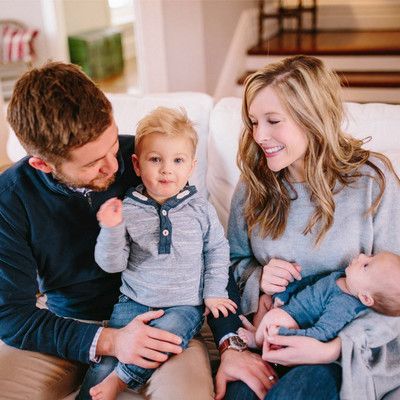
About the author
Cory Adkinson
Cory Adkinson is the owner and operator of 314 Exchange, a premier wedding and event venue. With a passion for creating unforgettable experiences, Cory has dedicated his career to providing exceptional service and a beautiful setting for weddings, corporate events, and special occasions. As an expert in the event industry, he has a keen eye for detail and a commitment to excellence. Cory believes in building strong relationships with his clients and goes above and beyond to ensure their vision is brought to life. With his expertise and dedication, Cory has become a trusted name in the event industry and continues to exceed expectations.
